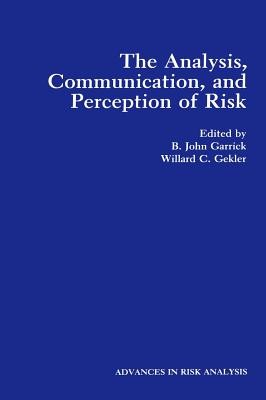
- We will send in 10–14 business days.
- Publisher: Springer
- Year: 1991
- ISBN-10: 030643833X
- ISBN-13: 9780306438332
- Format: 17.8 x 25.4 x 4 cm, hardcover
- Language: English
- SAVE -10% with code: EXTRA
The Analysis, Communication, and Perception of Risk (e-book) (used book) | bookbook.eu
Reviews
Description
The 1989 Annual Meeting of the Society for Risk Analysis dramatically demonstrated one of the most important reasons for having the Society - to bring together people with highly diverse backgrounds and disciplines to assess the common problems of societal and individual risks. The physical scientists emphasized the analytical tools for assessing environmental effects and for modeling risks from engineered systems and other human activities. The health scientists presented numerous methods of analyzing health effects, including the subject of dose-response relationships, especially at low exposure levels - never an easy analysis. The social and political scientists concentrated on issues of risk perception, communication, acceptability, and human touch. Others discussed such issues as cost-benefit analysis and the risk-based approach to decision analysis. Use of risk assessment methods for risk management continued to be a matter of strong opinion and debate. The impacts of state and federal regulations, existing and planned, were assessed in sessions and in luncheon speeches. These impacts show that risk analysis practitioners will have an increasingly important role in the future. They will be challenged to provide clear, easily understood evaluations of risk that are responsive to society's concern for risk, as evidenced in laws and regulations. Of course, the various risk analysis specialties overlapped in domains of interest.
EXTRA 10 % discount with code: EXTRA
The promotion ends in 15d.06:21:13
The discount code is valid when purchasing from 10 €. Discounts do not stack.
- Publisher: Springer
- Year: 1991
- ISBN-10: 030643833X
- ISBN-13: 9780306438332
- Format: 17.8 x 25.4 x 4 cm, hardcover
- Language: English English
The 1989 Annual Meeting of the Society for Risk Analysis dramatically demonstrated one of the most important reasons for having the Society - to bring together people with highly diverse backgrounds and disciplines to assess the common problems of societal and individual risks. The physical scientists emphasized the analytical tools for assessing environmental effects and for modeling risks from engineered systems and other human activities. The health scientists presented numerous methods of analyzing health effects, including the subject of dose-response relationships, especially at low exposure levels - never an easy analysis. The social and political scientists concentrated on issues of risk perception, communication, acceptability, and human touch. Others discussed such issues as cost-benefit analysis and the risk-based approach to decision analysis. Use of risk assessment methods for risk management continued to be a matter of strong opinion and debate. The impacts of state and federal regulations, existing and planned, were assessed in sessions and in luncheon speeches. These impacts show that risk analysis practitioners will have an increasingly important role in the future. They will be challenged to provide clear, easily understood evaluations of risk that are responsive to society's concern for risk, as evidenced in laws and regulations. Of course, the various risk analysis specialties overlapped in domains of interest.


Reviews